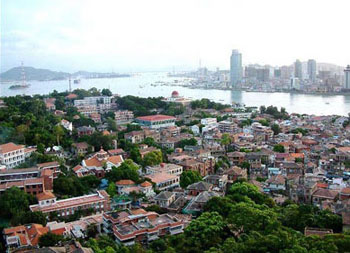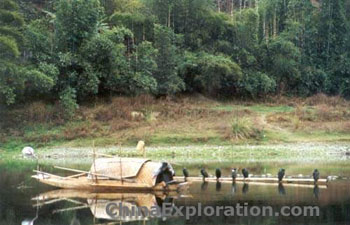search for a Trip
Introduction of Xiamen
Xiamen, the second largest city in Fujian province next to the capital Fuzhou, covers a total area of 1,516 square meters. As one of the five earliest special economic zones, with heavy investment from Taiwan and Hong Kong, it has been a city growing in strength. Despite its fame as an industrial powerhouse, this port city has not lost much of its charm, and as a sightseeing haven has become one of the best areas to visit in Fujian and for good reason: With good food, some great architecture and a mild to hot climate, Xiamen is hard to beat. Xiamen is a picturesque coastal city in southeast China, earning itself the nickname 'Pearl on the East China Sea'. The mild temperature, together with the convenient transportation, makes it a magnet for tourists inside and outside China.
Main attractions in Xiamen
Gulangyu Island

Gulangyu Island, located to the southwest of the city proper, is only about a five-minute journey by local ferry. The island has long had the name of 'above-the-sea garden' because of its variety of pretty flowers, the best of which can be viewed in the Shuzhuang Garden. The highest point on the island, the Sunlight Rock, is also the symbol of Xiamen city. Just as the saying 'one who has not visited the Great Wall is not a true hero', those who have not visited the Sunlight Rock cannot claim to have truly seen Xiamen.
Possibly due to the beautiful scenery here, people living on the island have a strong liking for music, boasting the highest piano ownership rates in China. Gulangyu Island is by far the best sight of this beautiful town, with its variety of colonial buildings, pleasant winding streets and musical locals. It is the best place to be located for those visiting this part of Fujian, although it is sometimes hard to find a room, especially for those on a budget. Very few of the sights here are spoiled, and there are so many charming features, from the profusion of ancient trees, all labeled, to the variety of seafood restaurants, most containing at least a few hideous monsters from the deep.
Shuzhuang Garden
 On the southern shore of Gulangyu Island is the Shuzhuang Garden (Shuzhuang huayuan), named after its original owner and built around 1900. The creators of this pretty garden attempted to create an environment that integrates the Gulangyu Island feel into its design: The Chinese will say that the garden is in the sea and the sea is in the garden. The overall impression here is pleasant. The pavilions, bridges and towers do not contrast against the natural sea views and profusion of trees.
On the southern shore of Gulangyu Island is the Shuzhuang Garden (Shuzhuang huayuan), named after its original owner and built around 1900. The creators of this pretty garden attempted to create an environment that integrates the Gulangyu Island feel into its design: The Chinese will say that the garden is in the sea and the sea is in the garden. The overall impression here is pleasant. The pavilions, bridges and towers do not contrast against the natural sea views and profusion of trees.
The Shuzhuang can be a great way to while away the day on this pretty and picturesque isle. The garden is full of many species of flowers, a botanist's delight, and there is also a clean, yellow sand beach that is a good way to brave the Chinese waters, although it can get a little full. Sipping a cup of tea in the garden's tea house or relaxing with a sea view under the shade of a Gulangyu tree is vacation bliss.
Oversea Chinese Museum
About 2 km south of Zhongshan Rd, the Overseas Chinese Museum (Huaqiao bowuguan) is an interesting way to spend an afternoon. The museum is dedicated to the many Fujianese and others from the southeast China region who have emigrated to various parts of the globe. The people of this part of China are well known for their nomadic tendencies. Even today, with the regional rapid economic improvements, many are still looking to get out and see the world. Today, over 2.5 million overseas Chinese, in no less than 50 countries, claim to have Fujian ancestry.
Founded by the wealthy industrialist Tan Kah-kee in 1959, the collection in the museum now contains pieces donated or invested in by many of these overseas Chinese, all putting money back into their roots. The museum is divided into six sections from relics of old China to photographic and pictorial evidence of Huaqiao (overseas Chinese) exploration. The ground floor's three halls contain paintings, photos and documentation of the Fujianese life abroad, an interesting way for foreigners to see the other side of the coin. The pottery and bronzes here are of particular interest, some of the pieces dating back as far as the Shang dynasty (1600-1100 BC).
Ten Thousand Rock
Ten-thousand-Rock in Lion Mountain in the east suburb of Xiamen is well-known for its countless grotesque rocks, some lying on cliffs, some standing on slopes, some looking like jade screens, some resembling an old man. Viewed from different angles, they present different features, like a man or an animal, but all vivid and alive. Hidden among the stone wall, are quite, attractive caves running through the hills, gurgling streams and precipitate waterfall giving off pearly sprays.
Standing on the Kuangyi Platform by the Changxiao Cave, one can have a bird's-eye-view of his 'Island of Egret' and experience its kaleidoscopic views. The Ten-Thousand-rock Botanical Garden, known as 'Green Museum', boasts more than four thousand species tropical and sugtropical plants, flourishing all the year round with their dazzling brilliance. The gigantic Golden Tiger fish Ferocactus is not only the king of the hundreds of cactus here but also one of the biggest in the country.
Nanputuo Temple
It is located on the southern outskirts of Xiamen, close to the Xiamen University, is the Nanputuo Temple (Nanputuo si), built during the Tang dynasty (618-907). The temple is in an attractive location, built onto the slopes of Wulao Hill (Wulao feng), and is definitely one of China's best temples. It is so named because it lies to the south of Putuoshan, one of the most respected Buddhist venues in China. Entering the front gate, you come to the Heavenly King Hall (Tian wang feng), which houses a huge laughing Buddha, accompanied by the four heavenly kings on either side. Behind the Buddha stands Wei Tuo, another deity, who is safeguarding the Buddhist doctrine. He has a stick in one of his hands, which points to the ground, a sign that the temple is rich enough to provide visiting monks with board and lodging.
Stepping out of the hall, you enter a courtyard, in front of which is the Great Heroic Treasure Hall (Daxiongbao feng), a two-storey building with three Buddhas representing the past, present and future. The Great Compassion Hall (Dabei feng), behind this, houses four statues of Guanyin (the goddess of compassion). Once passing through the main halls you will reach the Wulao Hill. The stones here are littered with characters such as 'On the heavenly border' or the more simple "Buddha", both official and unofficial. It is possible to scale up and over the hill, a bit of a task, to arrive at the Wanshi Botanical Gardens, in which is housed the giant redwood brought by Nixon in his groundbreaking visit to China.
Climate in Xiamen
The optimum time for visiting Xiamen is from May to July with warm, but not excessive, temperatures.
|
Month |
Jan |
Feb |
Mar |
Apr |
May |
Jun |
Jul |
Aug |
Sep |
Oct |
Nov |
Dec |
|
Temperature (Celsius) |
13 |
11 |
14.5 |
16.1 |
20.8 |
21.0 |
28.0 |
28.4 |
27.4 |
24.4 |
21.1 |
19.0 |
Click to see more Xiamen Tours
China Attractions Guide
- Anhui Attractions
- Beijing Attractions
- Chongqing Attractions
- Fujian Attractions
- Gansu Attractions
- Guangdong Attractions
- Guangxi Attractions
- Guizhou Attractions
- Hainan Attractions
- Henan Attractions
- Hongkong Attractions
- Hubei Attractions
- Hunan Attractions
- Inner Mongolia Attractions
- Jiangsu Attractions
- Jiangxi Attractions
- Manchuria Attractions
- Ningxia Attractions
- Qinghai Attractions
- Shaanxi Attractions


